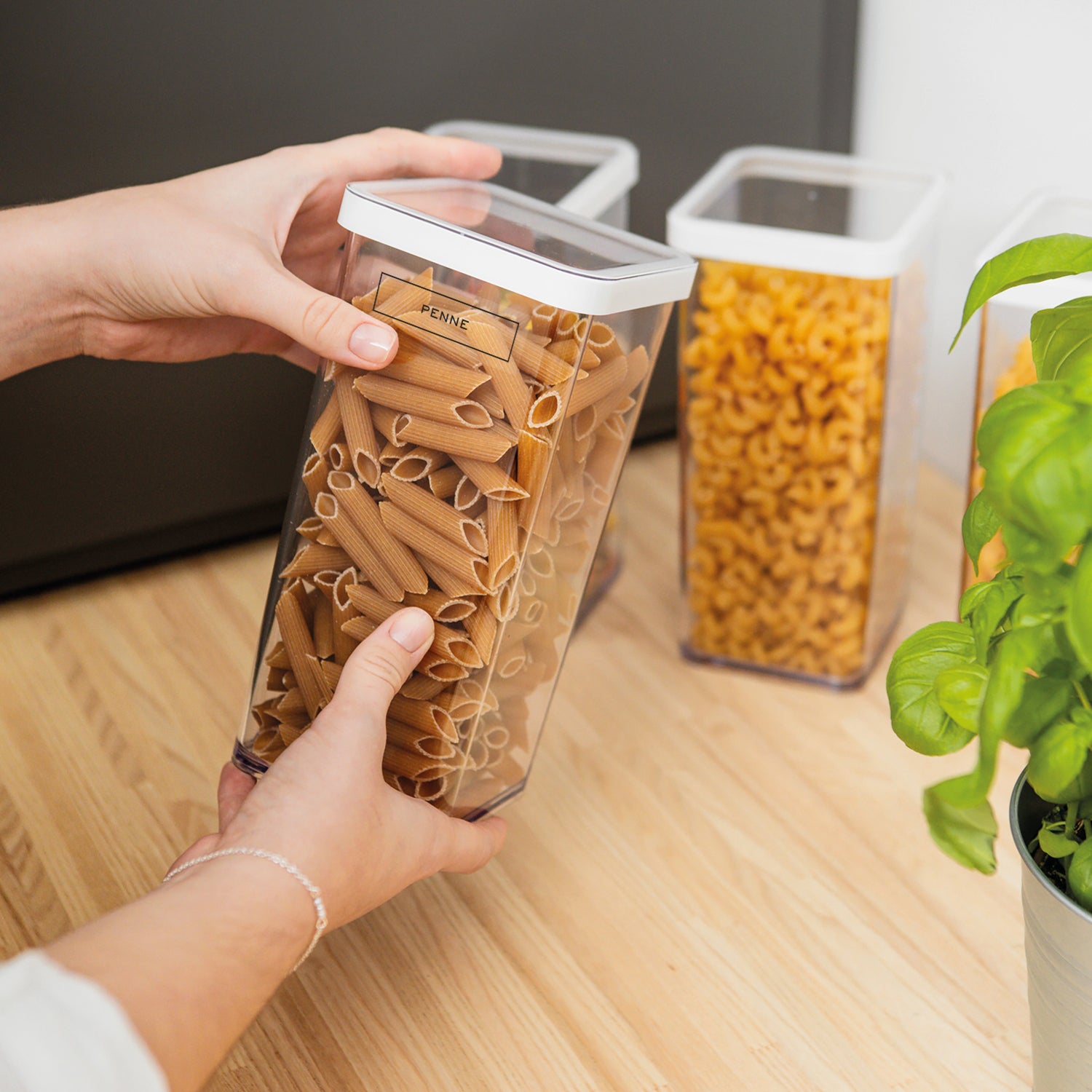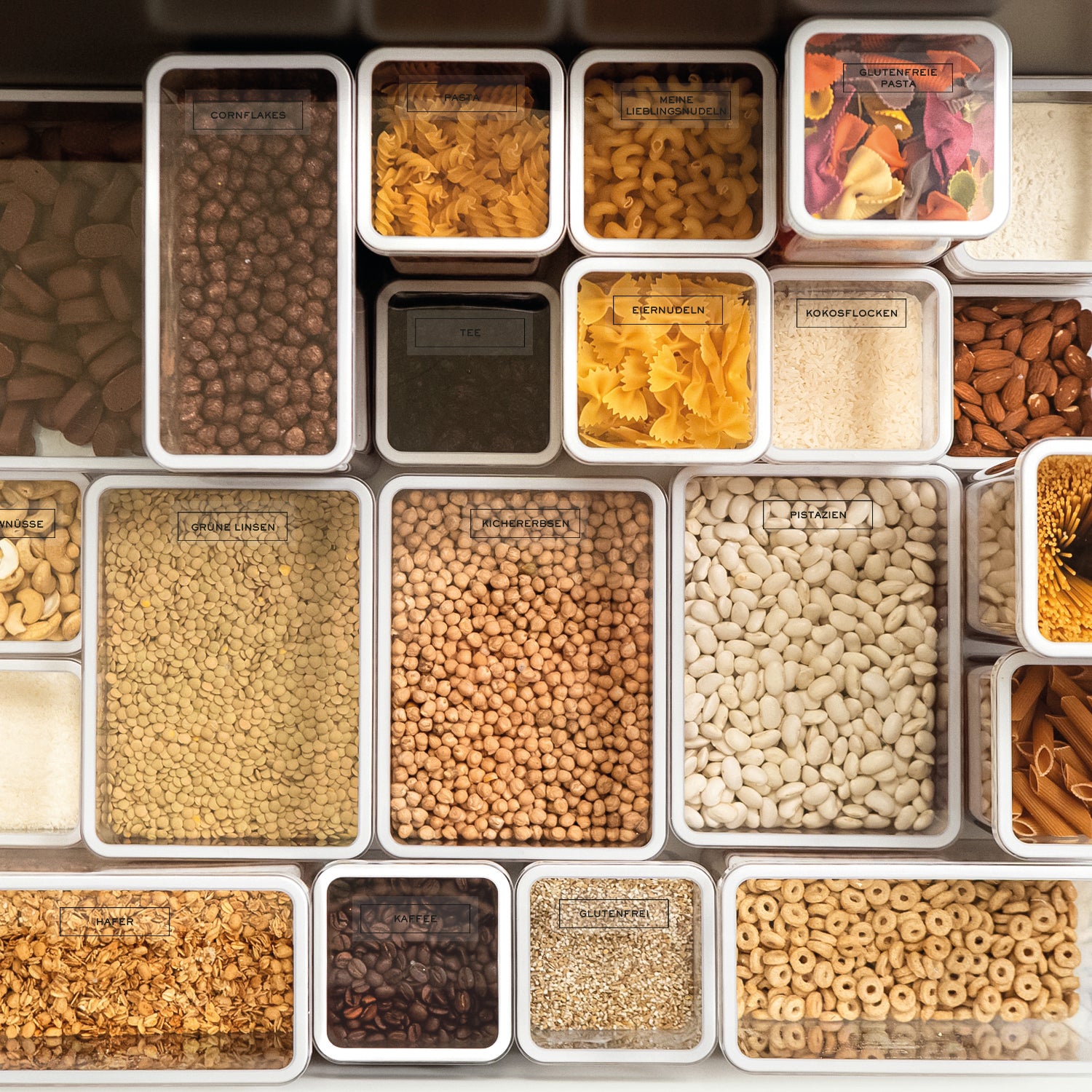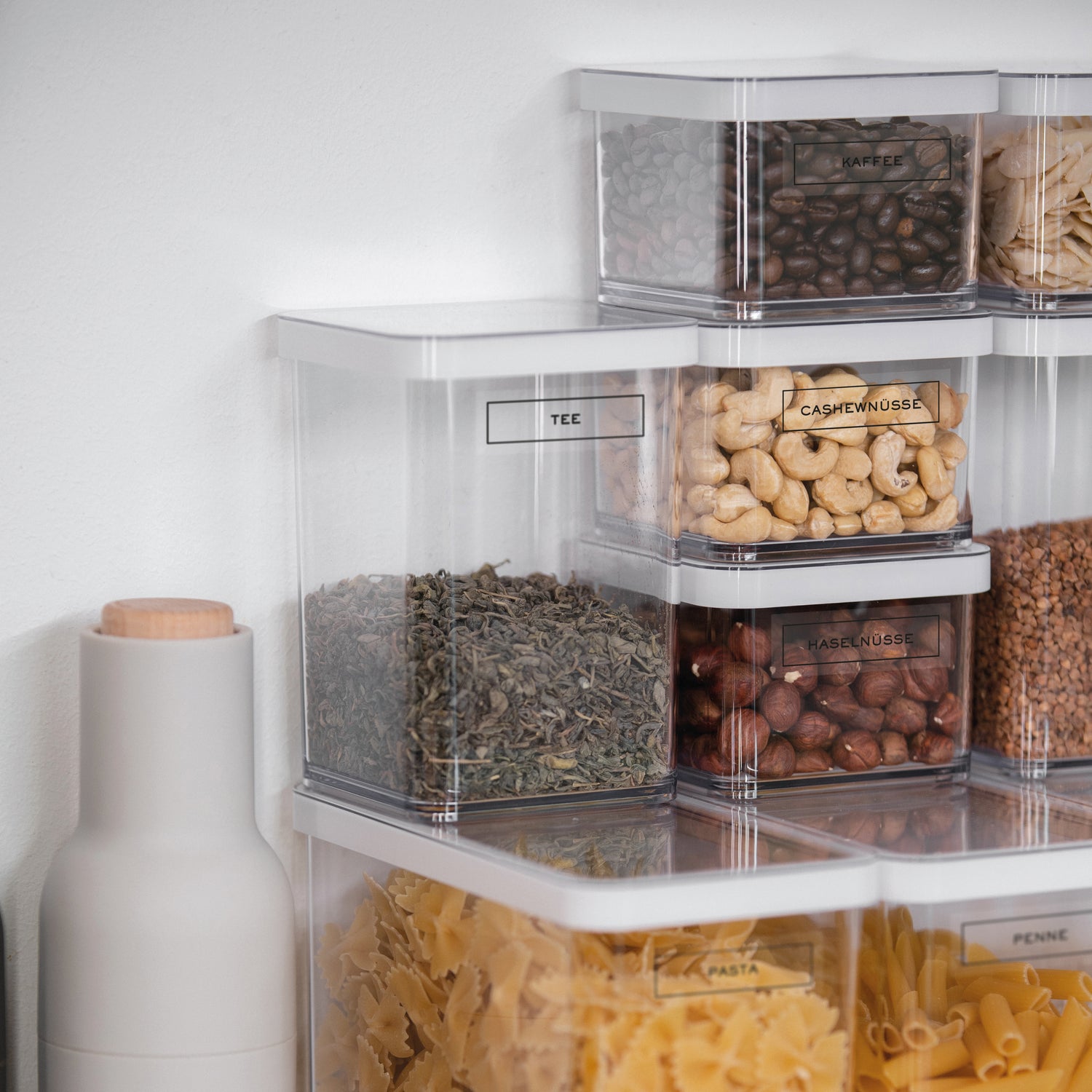From chaos in the closet to good organization with chic labels
Do you finally want your closet to be tidy? You have already taken the first step by buying these labels. We will now explain how to proceed. This booklet gives you the most important tips and tricks for organizing your cupboards and shelves sensibly. You will also receive instructions on what to look out for when using the labels.
Das Problem mit der Unordnung im Schrank
Closet doors open and you can't find anything - many people are familiar with the problem. There is simply no overview of what is in the cupboards. This creates unnecessary multiple purchases because the food you already have is hiding somewhere in the cupboard.
In addition, the new purchases are stuffed into the closet from the front and older things are pushed to the back. As a result, food often expires and unfortunately has to be thrown away.
It is even worse when the old food creates a problem, for example with food moths. Once you have these moths in your closet, it's hard to get rid of them. They quickly infest all other food, so that all supplies then have to be completely replaced. This is neither sustainable nor cost-effective.
Grundlagen zur Schrankorganisation
Zu Beginn eines Ordnungsprojektes musst du dir erstmal einen Überblick verschaffen, was du alles hast und ob die Gegenstände schlau platziert sind. Hierfür teilst du am besten alle deine Sachen in Kategorien ein. Zum Beispiel: Teller, Besteck, Kochutensilien, Vorräte, Lebensmittel fürs Frühstück, Gewürze, etc.
Bei der korrekten Platzierung im Schrank gilt es auf „Funktion“ und „Häufigkeit“ zu achten. Das bedeutet, dass die Gegenstände ihrer Funktion nach platziert werden. Zum Beispiel Gewürze und Kochutensilien nahe dem Herd oder Kaffee und Tassen nahe der Kaffeemaschine. So schafft man kurze Wege und erleichtert die Abläufe bei der Nutzung – und das spart Zeit.
Mit der Häufigkeit der Nutzung ist gemeint, dass Dinge, die nicht oft benötigt werden, an eher schwer erreichbare Stellen geräumt werden. Sachen, die man öfter benutzt, sollten hingegen schnell griffbereit platziert werden. Kuchenplatten, große Schalen oder besonderes Kochzubehör wie z.B. ein Wok sind Gegenstände, die eher selten benutzt werden und deswegen ganz nach oben oder in Ecken geräumt werden können. Tassen und Gläser sind gut auf Augenhöhe in den Hängeschränken zu verstauen. Für Teller, Töpfe und Lebensmittel bietet sich der Bereich unter der Arbeitsplatte an.
Wichtig ist vor allem, dass die Ordnung für dich Sinn ergibt und zu deinen Gewohnheiten passt.
Drei typische Fehler beim Organisieren von Schränken
1. Unused cabinet height
The wrong sizes of containers are often bought that do not use the full height of the drawer or cabinet. On the other hand, with high containers, the space at the top can be used optimally and there is more space available in length and width for additional containers.
2. Containers that are too small
Another mistake is when the size of the containers is selected based on opened packages. If a new, full pack is then bought, it only partially fits in and there is something left over. Therefore, always assume the full pack. Note that storage can sizes are in liters, not kilograms.
3. Label placed illegibly
When using labels, it can happen that they are not positioned correctly. For example, if they are attached too far down or on the wrong side, the label is no longer visible. It is therefore advisable to gradually increase the container size backwards so that you can always read the label in the upper part of the container.
Die Verwendung der Labels
1. The right placement
It is important that the labels are placed uniformly and are easy to read – preferably in the middle and always at the same height.
For storage containers in drawers, you should attach the label to the lid.
So you can easily read everything when you open the drawer and quickly find what you are looking for
2. Cooking time and best before date
Cooking time and best before date can be easily recorded on the container with a water-soluble pen. There are blank labels for writing on them, or you can also write the information directly on the containers.
3. Important notices
Special attention must be paid to allergies and food intolerances when labeling. Otherwise, important information could be lost and a health risk could arise. Two special labels are included in this set, each indicating that nuts or gluten-free products are included. Simply attach the respective warning directly under the label and rest assured that it will not be overlooked.
Schrankorganisation Step by Step
1. Everything out
Here we go: First clear all the groceries out of the cupboards so that you can take stock. This is the only way you can get an overview.
2. Categorize
Before the food can be sorted and decanted, it must first be scanned for moths and the expired best-before date. Then you can divide all supplies into groups according to different categories.
3. Sort out
Then you sort out everything that you no longer need or that has expired. Expired food naturally goes in the trash. Treats that you can't use yourself but are still good can also be given away.
4. Find a suitable place
Now you think about where you can best store the groceries. For example, how often you use which food can be decisive for the location. Of course, the more you use them, the easier and faster they should be accessible.
5. Storage tank
If you don't have any storage jars yet, first measure the cupboard or drawer and choose suitable containers based on the criteria mentioned above.
6. Decant
Now fill all the food into the respective containers and write down the best-before date and/or the cooking time on the containers, if you wish.
7. Labeling
Finally, you label the containers. Simply peel off the sticker and stick it in the desired place. Press again and you're done.
Noch ein paar Tipps zum Abschluss
Use generic terms: For products that change frequently, but which can be grouped together, you can use a generic term as a label. For example, just “pasta” instead of the exact kind. So you don't have to re-label the containers every time you change the pasta type.
Collection basket instead of storage jar: With food that is only bought for testing or very rarely, it is not necessarily worth transferring it to a storage jar. It is best to leave these items in their original packaging and collect them in larger baskets. If possible, these should also be airtight, since vermin can eat through the original packaging. Refills can also be stored here
Auf die Labels, fertig, los!
Jetzt kennst du die wichtigsten Tipps, um dein kleines Ordnungsprojekt zu meistern. Du wirst sehen wie viel leichter die Abläufe in deiner Küche werden und wie viel Zeit du sparst, weil du nicht mehr so lange suchen musst. Schnell kannst du erkennen, wovon du Nachschub kaufen musst. Dir werden weniger Lebensmittel ablaufen, wodurch du Geld sparst. Außerdem macht es einfach viel mehr Freude in einer gut organisierten Küche zu kochen.
Und nun viel Spaß mit den schicken Labels und bei der Umsetzung der Tipps.






